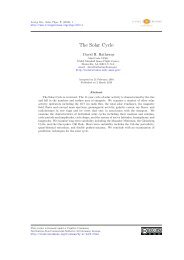PDF (for b&w printout) - Living Reviews in Solar Physics
PDF (for b&w printout) - Living Reviews in Solar Physics
PDF (for b&w printout) - Living Reviews in Solar Physics
You also want an ePaper? Increase the reach of your titles
YUMPU automatically turns print PDFs into web optimized ePapers that Google loves.
The Sun <strong>in</strong> Time: Activity and Environment 25<br />
with respect to the ambient gas pressure, i.e., the field strength is primarily dependent on spectral<br />
type, although a weak activity dependence is also present (e.g., Montes<strong>in</strong>os and Jordan, 1993). The<br />
higher fill<strong>in</strong>g factors lead to less expansion of photospheric/chromospheric flux tubes because the<br />
tubes merge with adjacent tubes (Cuntz et al., 1999). There<strong>for</strong>e, toward more active stars, coronal<br />
magnetic fields <strong>in</strong>teract progressively more frequently due to their denser pack<strong>in</strong>g. A higher rate of<br />
large flares is a consequence. S<strong>in</strong>ce flares enhance the electron density along with the temperature,<br />
stars with a higher activity level should reveal a predom<strong>in</strong>ance of hotter structures (Güdel et al.,<br />
1997b). Such a trend is observationally well supported; as further described <strong>in</strong> Section 5.5.2 below,<br />
coronae at higher activity levels are systematically hotter.<br />
4.3 Activity cycles <strong>in</strong> the young Sun<br />
Records of sunspot numbers back over several hundred years show a near-cyclic modulation that<br />
has turned out to be a central challenge <strong>for</strong> dynamo theories. The activity period between two<br />
successive spot maxima is approximately 11 years; because the magnetic polarity reverses after<br />
one period, the full magnetic cycle amounts to 22 yr. Activity cycles correspond<strong>in</strong>g to the 11 yr<br />
solar cycle have been found on many cool stars, mostly as a result of the Mount Wilson HK project<br />
(Baliunas et al., 1995) that has collected a cont<strong>in</strong>uous data stream of the chromospheric Ca ii H<br />
& K l<strong>in</strong>e flux diagnostic <strong>for</strong> many stars over several decades. A subset of stars appear to lack<br />
such cycles, however, and very active stars tend to exhibit an irregular rather than a cyclic mode<br />
of variability (Hempelmann et al., 1996). An alternative method <strong>for</strong> f<strong>in</strong>d<strong>in</strong>g activity cycles on<br />
magnetically active stars is the identification of cycles <strong>in</strong> the starspot coverage.<br />
4.3.1 Starspot cycles of solar analogs<br />
Mess<strong>in</strong>a and Gu<strong>in</strong>an (2002) specifically studied starspot cycles of stars from the “Sun <strong>in</strong> Time”<br />
program. Activity cycles are found <strong>in</strong> all of them, with periods rang<strong>in</strong>g from 2.1 yr to 13.1 yr.<br />
A comparison with the more comprehensive survey and the theoretical <strong>in</strong>terpretations presented<br />
by Saar and Brandenburg (1999) confirms the presence of two or three branches: i) <strong>in</strong>active solar<br />
analogs show cycles about 100 times longer than the rotation period, P ; ii) active stars reveal<br />
cycles 200 – 600 times longer than P ; iii) and “super-active” stars show cycles about 4 order of<br />
magnitude longer than P (Figure 7a). Among G-type stars, only EK Dra appears to be compatible<br />
with the third class (Mess<strong>in</strong>a and Gu<strong>in</strong>an 2002).<br />
The brightness amplitude <strong>in</strong>creases with <strong>in</strong>creas<strong>in</strong>g <strong>in</strong>verse Rossby number (i.e., <strong>in</strong>creas<strong>in</strong>g<br />
rotation rate <strong>for</strong> constant turnover time), <strong>in</strong>dicat<strong>in</strong>g that spots produce progressively more modulation<br />
toward higher activity levels (Figure 7b). A plateau is suggested <strong>for</strong> the most active stars,<br />
<strong>in</strong>dicat<strong>in</strong>g a saturation effect when spots cover a large fraction of the stellar surface (Mess<strong>in</strong>a and<br />
Gu<strong>in</strong>an, 2002).<br />
The standard near-ZAMS solar analog, EK Dra, has been an important target <strong>for</strong> cycle studies.<br />
Dorren and Gu<strong>in</strong>an (1994a) and Dorren and Gu<strong>in</strong>an (1994b) showed that its long-term photometric<br />
variations by ≈ 0.07 mag are consistent with a period of about 12 yr. Variations compatible with<br />
this time scale are also found <strong>in</strong> Ca ii HK, Mg ii h and k, and the ultraviolet C iv, C ii, and He ii<br />
fluxes (Dorren and Gu<strong>in</strong>an, 1994a), and <strong>in</strong> X-rays (see Section 4.3.2 below). The spot periodicity<br />
has been confirmed by Mess<strong>in</strong>a and Gu<strong>in</strong>an (2002) although their best estimate <strong>for</strong> the period is<br />
9.2 ± 0.4 yr (Figure 8). The star is optically fa<strong>in</strong>test when chromospheric and transition-region<br />
activity is highest. On top of this cyclic behavior, there is a long-term trend <strong>in</strong> the optical light,<br />
namely a decl<strong>in</strong>e of the blue light by 0.0017 ± 0.0004 mag yr −1 <strong>for</strong> an <strong>in</strong>vestigated time span of<br />
35 yr (Fröhlich et al. 2002; see also Mess<strong>in</strong>a and Gu<strong>in</strong>an 2003 and Järv<strong>in</strong>en et al. 2005). Further,<br />
two active longitudes shift <strong>in</strong> phase <strong>in</strong> concert with the activity cycles (Järv<strong>in</strong>en et al., 2005). The<br />
dom<strong>in</strong>ant spot concentration switches between the two preferred longitudes with a “flip-flop” cycle<br />
<strong>Liv<strong>in</strong>g</strong> <strong>Reviews</strong> <strong>in</strong> <strong>Solar</strong> <strong>Physics</strong><br />
http://www.liv<strong>in</strong>greviews.org/lrsp-2007-3



